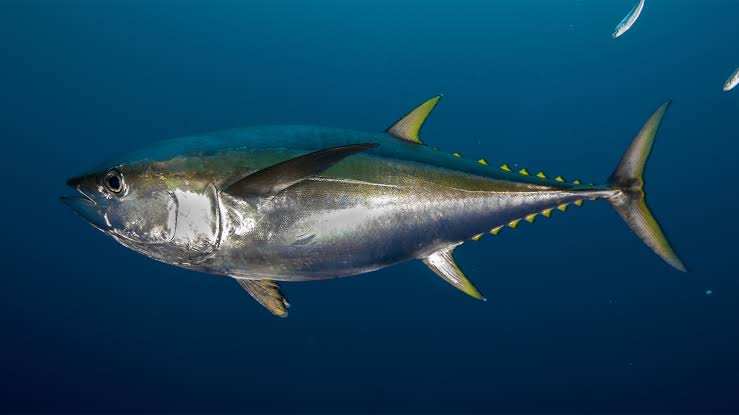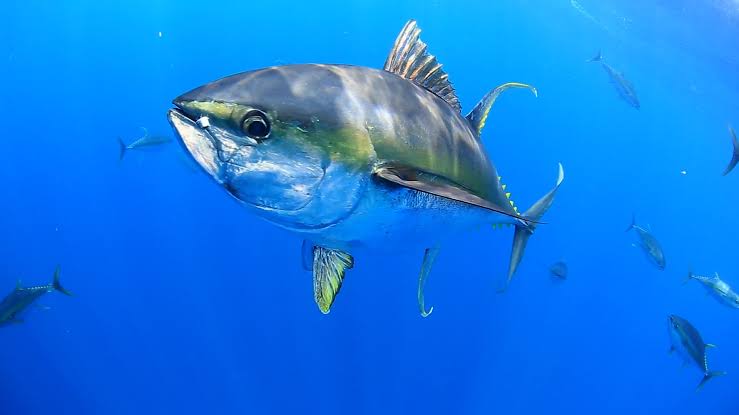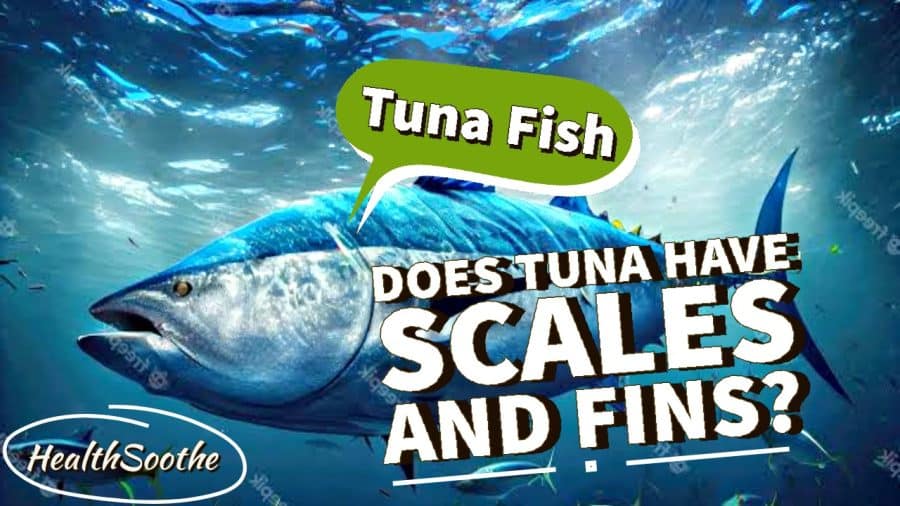Are you a fan of seafood? Then there’s a 100 percent chance that you’ve come across tuna, one of the most popular and widely consumed fish in the world.
[ninja_tables id=”68280″]
Tuna is a little different from other fish. It has smooth skin, which has left many wondering whether this delicious fish has scales and fins like other aquatic creatures. Even though, tuna is a very popular and widely consumed seafood around the world, not everyone knows the details about its physical makeup
If you’re one of them, then read this article till the end as it will answer all your burning questions and satisfy your curiosity about Tuna. We’ll explore the facts about the different species of tuna that exist in our oceans today and how they are classified based on their physical characteristics.
But before we dive into those details, let’s first address a common question asked by many people: Does Tuna Have Scales And Fins? We’ll also share some interesting facts about these ocean-dwelling creatures along the way. Trust me, by the time you finish reading this article, you’ll begin to feel like a tuna expert in no time (pun intended).
Does Tuna Have Scales and Fins?
Tuna is a popular fish that many people enjoy eating. But have you ever wondered if tuna has scales and fins? The answer is yes, tuna does have scales and fins just like any other fish.
The scales on tuna called “scutes” are quite small and they overlap each other, giving the skin a smooth texture. This makes it difficult to see the individual scales unless you look very closely. Tuna also has large dorsal and pectoral fins and also a anal, pelvic and tail fin that helps it swim through the water with ease.
While some species of tuna can grow quite large, their size doesn’t affect their scale or fin count. Each species of tuna will have its own unique appearance but all will have both scales and fins.
So next time you’re enjoying a delicious piece of tuna sushi or grilled tuna steak, remember that this tasty fish has both scales and fins just like any other fish in the ocean!
Where Are Tuna Scales Located?
Tuna scales are located all over its body, except for their head and fins. Unlike other types of fish that have visible scales covering their entire body, tuna scales are much smaller and less noticeable.
These tiny scales are silvery to almost black in color. Their primary purpose is to protect them against predators in the oceans by providing a form of barrier between the internal organs of the fish and its external environment. So technically, tuna fish scales act like armor.

How Do Fish Scales Help The Fish?
Fishes have scales for a variety of reasons, but the main purpose is to provide them with protection and help them move through water more quickly and efficiently.
Scales act as a barrier against injuries from predators, parasites, and rough surfaces in their environment. Fish scales also help regulate buoyancy by reducing drag and making it easier for fish to swim at different depths. Some species of fish have specialized scales that can change color or reflect light to camouflage themselves from predators or attract prey.
So, in a nutshell, without the protective layer provided by their scales, most fishes would not survive long enough to reproduce. Fish rely heavily on this natural armor for defense against potential attackers in aquatic environments while also allowing their optimal movement within their underwater surroundings.
What Will Happen If A Fish Doesn’t Have Scales?
If a fish is without scales, the fish would be vulnerable to their environment and predators around. So, what will happen if a fish doesn’t have scales?
First of all, it is important to understand that scales are not just for protection. Scales help regulate water flow around the body of the fish and aid in buoyancy control. Additionally, they provide an efficient mechanism for gas exchange.
If a fish does not have scales, it may experience difficulty swimming due to improper regulation of water flow around its body. This can cause issues with buoyancy control leading to exhaustion and also their susceptibility to predators leading to death from being unable to swim properly.
Also, without protective scales covering their skin, fish are more susceptible to infections caused by parasites or bacteria present in their aquatic environment.
While some species of fish do not have visible external scales but instead possess other forms of armor-like features such as bony plates or hardened skin; most fishes rely on traditional scaly armor for survival in their aquatic habitats.
How Many Species of Tuna Are There?
Tuna is a popular fish that can be found in oceans all over the world. But just how many species of tuna are there? The answer may surprise you.
According to experts, there are 15 different species of tuna and each of them belong to the same family “Scombridae“. They are:
- Albacore tuna (Scientific Name: Thunnus albacares)
- Bigeye tuna (Scientific Name: Thunnus obesus)
- Blackfin tuna (Scientific Name: Thunnus atlanticus)
- Bluefin tuna (Scientific Name: Thunnus thynnus)
- Bullet tuna (Scientific Name: Auxis rochei)
- Frigate tuna (Scientific Name: Auxis thazard)
- Kawakawa tuna (Scientific Name: Euthynnus affinis)
- Little tunny (Scientific Name: Euthynnus alletteratus)
- Longtail tuna (Scientific Name: Thunnus tonggol)
- Slender tuna (Scientific Name: Allothunnus fallai)
- Skipjack tuna (Scientific Name: Katsuwonus pelamis)
- Southern bluefin tuna (Scientific Name: Thunnus maccoyii)
- Yellowfin tuna (Scientific Name: Thunnus albacares)
These species differ in size and coloration but share similar characteristics such as their torpedo-shaped bodies and streamlined shape. While we have over 15 different species of tuna fish, there are only 6 commonly known types, and they include Albacore, Yellowfin, Bluefin, Skipjack, Bigeye Tuna, and Blackfin Tuna.
Albacore can be found all over the world’s oceans while Yellowfin is more common in tropical waters. Bluefin is one of the largest tunas; they can weigh up to 1,500 pounds! On the other hand, skipjack tuna tends to be smaller at just a few feet long.
Bigeye Tuna gets its name because it has large eyes compared to other tunas. They’re also quite big themselves – typically weighing between 20-100 lbs depending on where they were caught or how old they are when harvested. Blackfin tuna is another type that’s often used for sushi rolls or sashimi dishes. It has black fins hence its name.
Which Species of Tuna Does Not Have Scales?
There are several species of tuna, but not all of them have scales. The most common type of tuna that does not possess scales is the skipjack. This species belongs to the same family as other tunas such as yellowfin and bluefin, but differ in a few key ways.
Skipjack tuna is usually smaller than other tuna, with an average weight between 4-8 pounds. They have a dark-blueish color on their back and white underbelly. Skipjacks are commonly found in tropical waters worldwide.
It’s important to note that even though this species don’t have visible scales like other fish do; it still contains small scales embedded within its skin such as ones on the corselet (behind the head) and the lateral line (a faint line running down each side of the fish).
What is the World Record for the Biggest Bluefin Tuna Ever Caught
The bluefin tuna is a highly prized fish among anglers and seafood lovers alike. It’s no surprise that many fishermen set out to catch the biggest one they can find. But what is the world record for the biggest bluefin tuna ever caught?
According to the International Game Fish Association (IGFA), the largest bluefin tuna ever caught weighed in at a whopping 1,496 pounds! This massive fish was caught off the coast of Nova Scotia in 1979 by angler Ken Fraser.
To put this into perspective, that’s about as much as two adult grizzly bears combined! It took Fraser over four hours to reel in this monster of a fish, with help from his crewmates.
Since then, there have been several attempts to break this record but none have succeeded. The current world record remains unbeaten after more than 40 years!
Does Tuna Contain High Levels of Mercury?
One of the concerns when it comes to consuming saltwater fish is its mercury content. Mercury is a toxic substance that can negatively affect human health, especially in high doses. Unfortunately, tuna tends to contain higher levels of mercury content than many other types of fish.
This is because tuna are larger predators and they tend to feed on smaller fish that have also accumulated some amount of mercury in their bodies. The longer-lived and larger the tuna, the more mercury they can accumulate over time.
The amount of mercury in tuna can vary depending on the species, where it was caught, and its size. Generally, Albacore tuna, which is a type of larger tuna, contains the highest level of mercury content of all the tuna species while skipjack tuna, which is a type of light tuna, has the lowest level of mercury content.
However, this does not mean you have to avoid eating tuna altogether. The key here is moderation – limit your intake of albacore or larger species of tuna to 12 ounces per week if you are an adult and only 6 ounces if you’re pregnant, a nursing mother or a younger child.
To reduce your exposure to mercury even more when consuming larger species of tuna, opt for smaller species like skipjack or canned light tuna which generally contain lower levels compared to larger species like Bluefin or Albacore Tuna.
Can You Eat Tuna Fish While Pregnant?
Pregnancy is a time of careful consideration when it comes to certain food choices. Many expectant mothers wonder whether they can safely eat tuna during pregnancy. The answer to this question depends on several factors.
First of all, the species of tuna matters. Albacore or “white” tuna has higher levels of mercury than other types and should be limited during pregnancy. It’s recommended that pregnant women consume no more than 6 ounces per week.
Also, the method of preparation matters as well. Raw or undercooked seafood can increase the risk of foodborne illness, which can be particularly dangerous for pregnant women and their developing babies.
While some types and amounts of tuna are safe for pregnant women, it’s important to consult with your healthcare provider before adding it to your diet.

Are Bluefin Tuna Endangered?
Yes, overfishing has led to a significant decline in their populations worldwide. As a result, bluefin tuna are now considered an endangered species.
The main cause of this rapid decline is overfishing, particularly by industrial fishing fleets that target these large fish for commercial purposes. Bluefin tuna take a long time to mature and reproduce slowly, making them especially vulnerable to overfishing.
In addition to overfishing, other factors such as habitat destruction and pollution have also contributed to the declining numbers of bluefin tuna. Climate change may also be affecting their populations by altering ocean currents and temperatures.
To address this issue, many countries have implemented strict regulations on fishing quotas and sizes for bluefin tuna catches. Conservation efforts are underway worldwide with hopes of saving this important species from extinction.
It’s important that we recognize the impact our actions have on marine life like the bluefin tuna and work towards sustainable practices so future generations can enjoy them too.
In Summary
Tuna is a popular fish that has become a staple in the diets of many people around the world. It is known for its high protein content and numerous health benefits.
When it comes to whether or not tuna has scales and fins, the answer is yes. All species of tuna have both scales and fins, which are necessary for their survival in their natural habitat but they’re so small and unnoticeable that you think they don’t exist but they actually do.
While there are concerns about mercury levels in certain types of tuna, pregnant women can still safely consume canned light tuna but in moderation.
It’s important to choose sustainably caught species of tuna whenever possible to support healthy oceans and protect endangered species like bluefin tuna from extinction.


